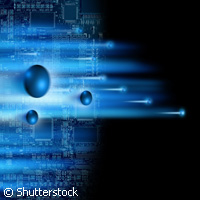Researchers make new ground in remote quantum entanglement�
European researchers have made new ground in the field of quantum mechanical entanglement of remote quantum systems. The team, from the Max Planck Institute of Quantum Optics in Germany, was able to demonstrate how two remote atomic quantum systems can be prepared in a shared 'entangled' state. This means that one system is a single atom trapped in an optical resonator, and the other one is a Bose-Einstein condensate (BEC) consisting of hundreds of thousands of ultracold atoms. A milestone in quantum network development has been reached as a result of the hybrid system of two remote, entangled, stationary nodes the team generated as part of the study, which was given a boost of EUR 5.3 million as part of the AQUTE ('Atomic quantum technologies') project funded under the 'Information and communication technologies' Theme of the EU's Seventh Framework Programme (FP7). It was Albert Einstein who first labelled the quantum mechanical phenomenon of entanglement 'spooky action at a distance' due to its strange consequences. Physicists have been trying for years to develop concepts that could use this phenomenon for practical purposes such as safe data transmission, where the entanglement which is generated in a local process has to be distributed among remote quantum systems. In addition, such networks might also help in the development of a universal quantum computer in which quantum bits can be exchanged with photons between nodes designed for information storage and processing. In the quantum mechanical phenomenon of entanglement, two quantum systems are grouped together in such a way that their properties become strictly correlated, which requires the particles to be in close contact. However, for many applications in a quantum network, it is necessary that entanglement is shared between two remote nodes called 'stationary' quantum bits. One way to achieve this is to use photons or 'flying' quantum bits for transporting the entanglement. In many ways this is similar to classical telecommunication where light is used to transmit information between computers or telephones. In the case of a quantum network, however, this task is much more difficult as entangled quantum states are extremely fragile and can only survive if the particles are well isolated from their environment. The German team who worked on the study has moved things forward by preparing two atomic quantum systems located in two different laboratories in an entangled state. This can be viewed on the one hand as a single rubidium atom trapped inside an optical resonator formed by two highly reflective mirrors, and on the other hand an ensemble of hundreds of thousands of ultracold rubidium atoms which form a BEC. In a BEC, all particles have the same quantum properties so that they all act as a single 'superatom'. 'A BEC is very well suited as a quantum memory because this exotic state does not suffer from any disturbances caused by thermal motion,' explains Matthias Lettner, one of the study's authors. 'This makes it possible to store and retrieve quantum information with high efficiency and to conserve this state for a long time. The exchange of quantum information between photons and atomic quantum systems requires a strong light-matter interaction. For the single atom, we achieve this by multiple reflections between the two resonator mirrors, whereas for the BEC the light-matter interaction is enhanced by the large number of atoms.' The overall objectives of the AQUTE project are to develop quantum technologies based on atomic, molecular and optical (AMO) systems for scalable quantum computation and entanglement-enabled technologies like metrology and sensing. In addition, the project hopes to establish and exploit new interdisciplinary connections, coming from AMO physics, but also including concepts and experimental settings of solid state systems, in order to reinforce interdisciplinary links at the frontiers of quantum information science, and other fields of physics or science in general as well as achieve novel hybrid systems that couple in a coherent way physically different quantum degrees of freedom.For more information, please visit: Max Planck Institute of Quantum Optics: http://www.mpq.mpg.de/cms/mpq/en/index.html
Countries
Germany



